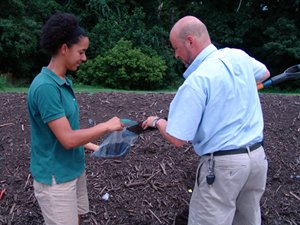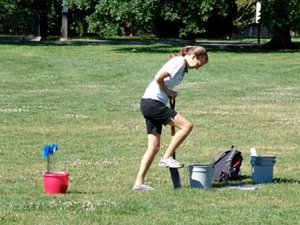Organic Lawn Grows at Swarthmore Thanks to Collaborative Campus Effort
Organic Lawn Grows at Swarthmore
Thanks to Collaborative Campus Effort
by Alex Weintraub '11 and Mariam Zakhary '13
8/18/10

This summer, several members of the Swarthmore community began collaborating on an extensive project to create an organically maintained lawn at the heart of campus. The group includes current students, alumni, and faculty and staff members and represents the College's ongoing commitment to a greener, more sustainable campus. Their goal is to maintain the five-acre field between Mertz Hall and Magill Walk with compost instead of standard synthetic herbicides and fertilizers.
"My biggest hope for this project is that our example gives other public institutions the confidence to try managing their landscapes with an organic approach," says Scott Arboretum gardener Nicole Lewis '02, who initiated the effort after being inspired by a similar project at Harvard University. "Right now, I think a lot of places feel that they have to choose environmental values or aesthetics and efficiency. Hopefully, we will hone a system that satisfies all of these priorities."
Lewis received a grant from the Swarthmore Foundation for her work, along with support from Associate Professor of Biology José-Luis Machado and Professor of Engineering Carr Everbach. Everbach, co-chair of the College's Sustainability Committee, and his summer intern, Andy Bastian '12, are also helping by designing two solar-powered compost tumblers that they hope to employ soon.
Over the past few months, Bastian has worked to redesign and convert two AC-powered compost tumblers to operate with a battery charged with solar power obtained from photovoltaic panels. Prior to this summer, he had little experience with composting and says the work has been an important opportunity to learn more about the process while gaining practical experience in the field of engineering.

"In all aspects of the project, I've had the opportunity to apply the critical thinking and problem solving skills that are the underlying curriculum of engineering classes at Swarthmore," says Bastian, an engineering major from Charlottesville, Va. "It's definitely not all about just making a machine work. It's about communicating clearly with everybody involved, understanding their needs, and addressing them properly."
Also working closely with Lewis is Camille Robertson '13, a student liaison to the Sustainability Committee from Williamstown, Mass., who received a Summer Social Action Award from the Lang Center for Civic and Social Responsibility to help with the project. She began by running diagnostic tests to identify the present makeup of the soil, then prepared soil samples for lab analysis and determined the rate at which they are able to absorb water. She has also researched the biology of organic lawns and writes about the project on the Arboretum's blog. The transition from the project's research and development phase to its actual implementation will begin this fall.
Robertson says she is glad to play a significant role in the project and to get a behind-the-scenes view of the Arboretum's work on campus. "The College and Arboretum have always strived to be responsible stewards of the health of the Crum Creek watershed and its human inhabitants," she says. "In order to keep our community and environment healthy and sustainable, we are excited to push for the next innovation: organic lawns!"


